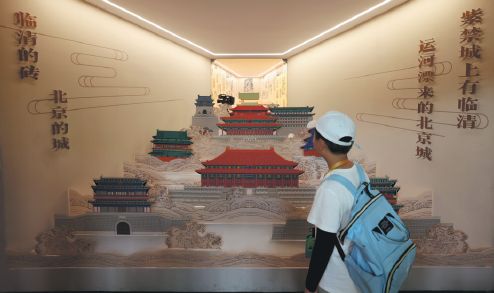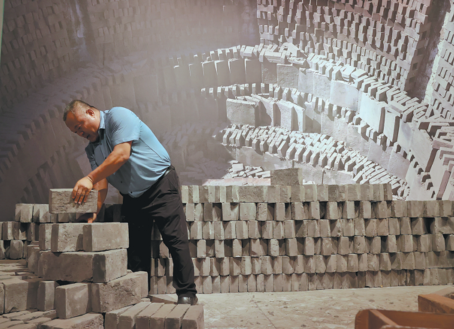Rebuilding a reputation, brick by Linqing brick
Master craftsman fires up his kiln and passion to produce quality product, Yang Feiyue reports.

The dulcet background guzheng (traditional Chinese zither) music permeating the Prince Kung's Palace Museum somehow accentuates the coarse yet stentorian voice of Zhao Qing'an in mid-July.
The man in his 50s nimbly runs around a makeshift stage where bricks, iron and wooden tools, and a kiln model are on display in a hall of the museum in Beijing.
He speaks fast and uses skits to demonstrate the production process of Linqing bricks, also known as tribute bricks, from Linqing, Liaocheng city of East China's Shandong province.
The brick had been favored by ancient royal courts since the Ming Dynasty (1368-1644) and thus serves as an important part of many historical buildings in the capital city.
Having been engaged in producing the tribute bricks for nearly two decades, Zhao is at home with the brick craft that was named a national intangible culture heritage in 2008.
He has been invited to an ongoing exhibition at the Prince Kung's Palace Museum that showcases the craftsmanship of those special bricks and will last through to Sunday.
When explaining the firing process, Zhao picks up an iron fork and a rod before a mock kiln.
"This iron fork is used to take out the slag from the kiln, and the rod is used to stir and mix the bricks during firing," he explains to a roomful of visitors to the exhibition.
Both these tools are indispensable throughout the brick firing, he adds.
Then, he hops over to a pile of brick models and beats them with two sets of wooden boards.
"They are made to match and roughly flatten the surface of unfired brick before manual fine-tuning kicks in," Zhao says.
The production of tribute bricks in Linqing began in the early Ming Dynasty and ended in the late Qing Dynasty (1644-1911), spanning more than 500 years.
According to the chronicle of Linqing, the royal court of Ming set up a branch office there to supervise the firing of tribute bricks, which were then transported to the country's capital via the Grand Canal for the construction of historical buildings like the Forbidden City, the Temple of Heaven, as well as various city gate towers and Confucian temples.
The Prince Kung's Palace Museum has more than 50 tribute bricks bearing the inscriptions indicating the names of ancient craftsmen and plants in Linqing, says Sun Dongning, deputy director of the museum's academic committee.
It reflected the production norms of Linqing tribute bricks, where responsibility was assigned to individuals, Sun explains.
Sun says that 90 percent of the bricks used in the buildings along Beijing's Central Axis are tribute bricks from Linqing, especially the wall bricks, making them an important cultural element.
Architects, generations ago, put a premium on Linqing brick for its superior quality, delightful color and malleability.
"The bricks can be molded into a variety of shapes and sizes. Thus, they are highly versatile for different construction needs," Zhao says. "They are also resistant to corrosion."
The local chronicle also recounted the bustling brick production scenes, where official kilns in Linqing were distributed in large numbers along the banks of the Grand Canal.
"The soil in Linqing, commonly known as 'lotus soil', is excellent, fine and free of impurities. Bricks made from this soil are exceptionally hard and produce a pleasant metallic sound when struck, making them ideal building material," Zhao says.
The "lotus soil" features layers of red, white, and yellow clay buried a meter deep in many places of Linqing and is a result of frequent floods from the Yellow River.
Additionally, the water in Linqing is clear and slightly alkaline, suitable for brickmaking, he adds.
The ideal production conditions and easy transportation via the canal are reasons behind the widespread presence of the bricks in Beijing, he explains.
As the country has stepped up efforts in protection and restoration of cultural relics, especially ancient buildings, tribute bricks have been in demand.
Born into a brick craftsmen's family, Zhao was exposed to the skill since childhood when he followed his father and grandfather to local brick plants.
He says he had remembered all the steps by heart, ranging from selecting and crushing soil, purifying and preparing clay, fashioning unfired bricks, loading and firing the kiln, inspecting the finished bricks, even though he didn't know exactly how they were executed.
"I never forget the damp smell of the clay in the kiln and the thick white smoke rising during the soaking process," he says.
Drawn to what it seemed like magic to him, Zhao started working as an apprentice of his father, and picked up the fundamental skills.
However, the lackluster development of the bricks had Zhao switch to the transportation business in the late 1990s to make a better living.
"Yet, the idea of making bricks sprang up in my mind from time to time," he recalls.
It wasn't until 2006 when he delivered tribute bricks to the provincial capital Jinan for restoring a gate in the Daming Lake scenic area, that he became optimistic and decided to follow his heart.
"There are so many ancient buildings that could use the bricks in Liaocheng, and not to mention those in Beijing," he says.
"I had my sights set on bringing Linqing bricks to the Palace Museum," he recalls.
The next year, he dug into his savings and had a kiln built in his hometown Zhaohui village and started to restore the traditional craft.
Based on his previous brickmaking experiences, Zhao carried out the traditional formula with precision.
"From preparing the raw materials to shaping the clay and firing the kiln, there are approximately 20 processes, and not a single one can be done carelessly," Zhao says.
For concocting the lotus soil, he mixed up the local red, white and yellow clays in a certain ratio and kept it buried for one to two years to let the mixture mature. "Maturing ensures that no air bubbles remain inside," Zhao says.
Creating the brick blanks (raw bricks) proves to be physically and technically demanding.
"A lump of clay weighs 35 to 40 kilograms, and it requires some strength to lift it, but strength alone is not enough. When molding the blank, you must fill the mold in one go, ensuring that all four corners and edges are fully filled without any defects," Zhao emphasizes.
The completed brick blanks need to be neatly stacked and dried, and only after passing inspection can they be loaded into the kiln for firing, he adds.
Biomass materials such as soybean and cotton stalks, and wood have been used as fuel, which guarantees a beautiful greenish-black brick color, Zhao says.
After firing for seven to nine days, water will be slowly sprinkled into the kiln for four to five days for balance.
Determining when to stop firing is crucial.
"Firing bricks is a technical and experience-based task. Some master craftsmen can judge the firing stage just by smelling," Zhao says.
"The fired bricks still need to be polished and processed, as buildings come in various forms, so the bricks need to be shaped in accordance with the architectural style."
Yet, the brick business wasn't smooth sailing at the beginning. The limited market channels Zhao had led to bleak bricks sales, putting him under pressure as he had many craftsmen to pay.
He says his family's support got him through. With his persistence for ensuring the bricks' quality, eventually business opportunities and supporting policies came his way.
In 2015, the Palace Museum used some of his bricks for restoring a royal garden and the experts decided they met all the requirements for ancient architectural restoration after a year of observation.
In 2016, Zhao managed to sign a supply contract with the Palace Museum.
Many constructions in Linqing and the rest of Liaocheng have since requested the old-fashioned bricks from Zhao's plant.
In 2019, he was named an inheritor of the craft by the Liaocheng authorities. Those achievements, in turn, have enabled him to deliver Linqing bricks to more restoration sites of historical architecture across the country.
Now, he has more than 100 employees from surrounding villages working for him.
"They work for about seven to eight months a year, since we don't fire bricks in winter, and each of them can earn an average of 50,000 to 60,000 yuan ($6,890-8,270)," Zhao says.
"Meanwhile, they can still take care of their own farm work, going back home to harvest corn and wheat when it's time," he says.
In 2020, his kiln factory was recognized by the Liaocheng authorities as a municipal intangible cultural heritage and poverty alleviation workshop.
Now that everything is on track, Zhao is aiming for his business to become a leader in making Linqing bricks.
"I feel it is my biggest responsibility to live up to the expectations of experts in the field, ensuring the consistency of our bricks' quality," he says.
"At the very least, I must pass down the craftsmanship as it was left by our ancestors."



Today's Top News
- Xi calls for promoting volunteer spirit to serve national rejuvenation
- Xi chairs CPC meeting to review report on central discipline inspection
- Reunification will only make Taiwan better
- Outline of Xi's thought on strengthening military published
- Targeted action plan to unleash consumption momentum
- Separatist plans of Lai slammed






























